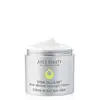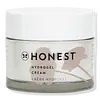What's inside
What's inside
 Key Ingredients
Key Ingredients

 Benefits
Benefits

 Concerns
Concerns

No concerns
 Ingredients Side-by-side
Ingredients Side-by-side

Vitis Vinifera Juice
AntioxidantAloe Barbadensis Leaf Juice
Skin ConditioningPyrus Malus Juice
Skin ConditioningCitrus Limon Juice
Skin ConditioningCaprylic/Capric Triglyceride
MaskingHelianthus Annuus Seed Oil
EmollientGlyceryl Stearate
EmollientStearyl Alcohol
EmollientCetyl Alcohol
EmollientStearic Acid
CleansingGlycerin
HumectantGlyceryl Stearate Citrate
EmollientSimmondsia Chinensis Seed Oil
EmollientButyrospermum Parkii Butter
Skin ConditioningVitis Vinifera Seed Oil
EmollientSqualane
EmollientOenothera Biennis Oil
EmollientCeramide NP
Skin ConditioningTocopherol
AntioxidantCapryloyl Glycerin
Narcissus Tazetta Bulb Extract
AstringentCitrus Limon Leaf Cell Extract
Skin ConditioningMalus Domestica Fruit Cell Culture Extract
Skin ConditioningVitis Vinifera Fruit Cell Extract
Skin ConditioningPalmitoyl Tripeptide-5
Skin ConditioningPanthenol
Skin ConditioningAllantoin
Skin ConditioningAscorbic Acid
AntioxidantChamomilla Recutita Extract
Skin ConditioningSodium Hyaluronate
HumectantSodium PCA
HumectantBeta-Glucan
Skin ConditioningDiheptyl Succinate
EmollientEthylhexylglycerin
Skin ConditioningSodium Phytate
Carbomer
Emulsion StabilisingCaprylyl Glycol
EmollientGluconolactone
Skin ConditioningCinnamomum Camphora Wood Oil
MaskingLitsea Cubeba Fruit Oil
MaskingCitral
PerfumingEthyl Linalool
MaskingLimonene
PerfumingVitis Vinifera Juice, Aloe Barbadensis Leaf Juice, Pyrus Malus Juice, Citrus Limon Juice, Caprylic/Capric Triglyceride, Helianthus Annuus Seed Oil, Glyceryl Stearate, Stearyl Alcohol, Cetyl Alcohol, Stearic Acid, Glycerin, Glyceryl Stearate Citrate, Simmondsia Chinensis Seed Oil, Butyrospermum Parkii Butter, Vitis Vinifera Seed Oil, Squalane, Oenothera Biennis Oil, Ceramide NP, Tocopherol, Capryloyl Glycerin, Narcissus Tazetta Bulb Extract, Citrus Limon Leaf Cell Extract, Malus Domestica Fruit Cell Culture Extract, Vitis Vinifera Fruit Cell Extract, Palmitoyl Tripeptide-5, Panthenol, Allantoin, Ascorbic Acid, Chamomilla Recutita Extract, Sodium Hyaluronate, Sodium PCA, Beta-Glucan, Diheptyl Succinate, Ethylhexylglycerin, Sodium Phytate, Carbomer, Caprylyl Glycol, Gluconolactone, Cinnamomum Camphora Wood Oil, Litsea Cubeba Fruit Oil, Citral, Ethyl Linalool, Limonene
Water
Skin ConditioningSqualane
EmollientGlycerin
HumectantPolyglyceryl-4 Isostearate
EmulsifyingPyrus Malus Fruit Extract
Skin ConditioningCoco-Caprylate/Caprate
EmollientPropanediol
SolventDisteardimonium Hectorite
StabilisingJojoba Esters
EmollientSodium PCA
HumectantTocopherol
AntioxidantSodium Acetylated Hyaluronate
HumectantHydrolyzed Sodium Hyaluronate
Skin ConditioningTrisodium Ethylenediamine Disuccinate
Ceramide AP
Skin Conditioning1,2-Hexanediol
Skin ConditioningCaprylhydroxamic Acid
Water, Squalane, Glycerin, Polyglyceryl-4 Isostearate, Pyrus Malus Fruit Extract, Coco-Caprylate/Caprate, Propanediol, Disteardimonium Hectorite, Jojoba Esters, Sodium PCA, Tocopherol, Sodium Acetylated Hyaluronate, Hydrolyzed Sodium Hyaluronate, Trisodium Ethylenediamine Disuccinate, Ceramide AP, 1,2-Hexanediol, Caprylhydroxamic Acid
 Reviews
Reviews

Ingredients Explained
These ingredients are found in both products.
Ingredients higher up in an ingredient list are typically present in a larger amount.
Glycerin is already naturally found in your skin. It helps moisturize and protect your skin.
A study from 2016 found glycerin to be more effective as a humectant than AHAs and hyaluronic acid.
As a humectant, it helps the skin stay hydrated by pulling moisture to your skin. The low molecular weight of glycerin allows it to pull moisture into the deeper layers of your skin.
Hydrated skin improves your skin barrier; Your skin barrier helps protect against irritants and bacteria.
Glycerin has also been found to have antimicrobial and antiviral properties. Due to these properties, glycerin is often used in wound and burn treatments.
In cosmetics, glycerin is usually derived from plants such as soybean or palm. However, it can also be sourced from animals, such as tallow or animal fat.
This ingredient is organic, colorless, odorless, and non-toxic.
Glycerin is the name for this ingredient in American English. British English uses Glycerol/Glycerine.
Learn more about GlycerinSodium PCA is the sodium salt of pyroglutamic acid. It is naturally occurring in our skin's natural moisturizing factors where it works to maintain hydration.
The PCA stands for pyrrolidone carboxylic acid, a natural amino acid derivative.
This ingredient has skin conditioning, anti-inflammatory, and humectant properties. Humectants help hydrate your skin by drawing moisture from the air. This helps keep your skin moisturized.
Learn more about Sodium PCASqualane is an emollient that helps the skin hold onto moisture. It's an oily liquid that occurs naturally in certain types of fish and plant oils.
Because squalane boosts hydration in the skin, it also comes with plenty of benefits: it is an antioxidant and can help fight free radicals and skin damage. Squalane is also found to have a detoxifying effect when applied.
Squalane comes from squalene, which occurs naturally within the sebum of our skin. It is one of the oils our skin produces to keep itself hydrated. Squalane is the hydrogenated version of squalene and has a longer shelf life.
Research shows that squalane is non-irritating (even at 100% concentration).
In general, it's a fantastic ingredient. It does a great job at hydrating the skin, and it's suitable for those with sensitive skin.
The source of squalane may impact malassezia / fungal acne. This is because olive oil derived squalane can contain impurities such as fatty acids and plant waxes. Sugarcane derived squalane is recommended for anyone with malassezia concerns.
Is squalane vegan?
This depends on the source. Squalane can be derived from both plants and animals. Most squalane used in skincare comes from plants.
Please note: the source of squalane is only known if disclosed by the brand. We recommend reaching out to the brand if you have any questions about their squalane.
Read more about squalene with an "e".
Is squalane an oil?
Squalane is often called an oil, but it’s technically not; it’s a hydrocarbon, meaning it’s only made of carbon and hydrogen, unlike true oils which are triglycerides made of fatty acids and glycerol.
The term “oil-free” isn’t regulated, so companies can define it however they want. Some exclude all oils, while others just avoid mineral oil or comedogenic oils.
While some people avoid oils thinking they cause breakouts, the right kind of oil (or oil-like ingredient like squalane) can actually help balance and hydrate your skin. It’s worth testing out simple oils or squalane to see what works best for your skin.
Learn more about SqualaneTocopherol (also known as Vitamin E) is a common antioxidant used to help protect the skin from free-radicals and strengthen the skin barrier. It's also fat soluble - this means our skin is great at absorbing it.
Vitamin E also helps keep your natural skin lipids healthy. Your lipid skin barrier naturally consists of lipids, ceramides, and fatty acids. Vitamin E offers extra protection for your skin’s lipid barrier, keeping your skin healthy and nourished.
Another benefit is a bit of UV protection. Vitamin E helps reduce the damage caused by UVB rays. (It should not replace your sunscreen). Combining it with Vitamin C can decrease sunburned cells and hyperpigmentation after UV exposure.
You might have noticed Vitamin E + C often paired together. This is because it is great at stabilizing Vitamin C. Using the two together helps increase the effectiveness of both ingredients.
There are often claims that Vitamin E can reduce/prevent scarring, but these claims haven't been confirmed by scientific research.
Learn more about Tocopherol